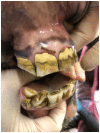The prevalence and risk factors of dental disease found in 100 miniature horses
- PMID: 38098989
- PMCID: PMC10720032
- DOI: 10.3389/fvets.2023.1239809
The prevalence and risk factors of dental disease found in 100 miniature horses
Abstract
Introduction: Dental disease is a common condition affecting horses. Its prevalence and characteristics among most of the common breeds of horses and donkeys have been investigated and described in the literature, but information about the prevalence and etiology of dental disease of miniature horses is sparse.
Methods: To determine the prevalence and characteristics of dental disease of miniature horses, we performed oral and dental radiographic examinations on 100 miniature horses. The findings of these examinations were analyzed to determine the prevalence of dental disease and its correlation to age, sex, weight, body condition score, height at the withers, head length and head width. Older horses had a higher prevalence of dental disease, diastemata and crown elongations.
Results: The most common dental diseases detected in this population were crown elongation, oral mucosal ulceration, diastemata, class 1 malocclusion and hypodontia. Horses with a high body condition score had an increased likelihood of having a class 1 malocclusion. Horses with wider heads had a higher prevalence of dental disease and class 1 malocclusions.
Conclusion: Frequent oral examinations, starting at an early age, should be prioritized as a part of miniature horse preventive health care to decrease morbidity and slow progression of dental disease.
Keywords: dental disease; equine dentistry; hypodontia; miniature horse; prevalence.
Copyright © 2023 Tinsley, Fogle, Means and Robertston.
Conflict of interest statement
The authors declare that the research was conducted in the absence of any commercial or financial relationships that could be construed as a potential conflict of interest.
Figures











References
-
- American Miniature Horse Association . About the breed. (2020). Available at: https://www.amha.org/breed-standards. (Accessed September 3, 2023)
-
- American Shetland Pony Club . AMHR. (2021). Available at: https://www.shetlandminiature.com/amhr. (Accessed September 3, 2023)
-
- Mitz C, Allen T. “Dentistry in miniature horses,” in Manual of equine dentistry. Ed. Allen T.. Mosby: Maryland Heights, MO: (2003). 175–91.
LinkOut - more resources
Full Text Sources

